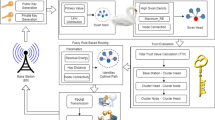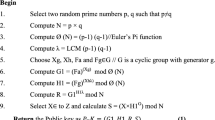Abstract
Due to dynamic changes, applications designed for the Internet of Things (IoT) require new storage resources. Storing IoT data in a fog infrastructure is a common practice to guarantee the IoT application’s high performance. Multiple fog nodes spread the data replica to accommodate multiple users and reduce access latency. However, such data replicas are subjected to intentional and accidental corruption. This paper proposes a data integrity verification approach in a distributed fog environment. The proposed work uses fuzzy clustering and consensus mechanism to verify the integrity of multiple replicas stored on distributed fog nodes. Security analysis shows that the proposed approach is highly resistant to replace, replay, and forgery attacks. Performance analysis demonstrates the practicability of the proposed approach in a fog environment.









Similar content being viewed by others
Availability of data and materials
Data sharing not applicable to this article as no datasets were generated or analyzed during the current study.
References
Gasmi K, Dilek S, Tosun S et al (2022) A survey on computation offloading and service placement in fog computing-based iot. J Supercomput 78(2):1983–2014. https://doi.org/10.1007/s11227-021-03941-y
Statista (????) Internet of things (iot) connected devices installed base worldwide from 2015 to 2025 (2016). https://www.statista.com/statistics/471264/iot-number-ofconnected-devices-worldwide/
Talal M, Zaidan A, Zaidan B et al (2019) Smart home-based iot for real-time and secure remote health monitoring of triage and priority system using body sensors: multi-driven systematic review. J Med Syst 43:1–34. https://doi.org/10.1007/s10916-019-1158-z
Dastjerdi AV, Gupta H, Calheiros RN et al (2016) Fog computing: principles, architectures, and applications. In: Internet of Things. Morgan Kaufmann, Massachusetts, pp 61–75. https://doi.org/10.1016/B978-0-12-805395-9.00004-6
Sarkar S, Chatterjee S, Misra S (2015) Assessment of the suitability of fog computing in the context of internet of things. IEEE Trans Cloud Comput 6(1):46–59. https://doi.org/10.1109/TCC.2015.2485206
Singh SP, Nayyar A, Kumar R et al (2019) Fog computing: from architecture to edge computing and big data processing. J Supercomput 75:2070–2105. https://doi.org/10.1007/s11227-018-2701-2
Huang T, Lin W, Li Y et al (2019) A latency-aware multiple data replicas placement strategy for fog computing. J Signal Process Syst 91:1191–1204. https://doi.org/10.1007/s11265-019-1444-5
Kaur J, Kumar R, Agrawal A et al (2022) A neutrosophic ahp-based computational technique for security management in a fog computing network. J Supercomput. https://doi.org/10.1007/s11227-022-04674-2
Ahmad M, Amin MB, Hussain S et al (2016) Health fog: a novel framework for health and wellness applications. J Supercomput 72:3677–3695
Ateniese G, Burns R, Curtmola R et al (2007) Provable data possession at untrusted stores. In: Proceedings of the 14th ACM Conference on Computer and Communications Security, pp 598–609. https://doi.org/10.1145/1315245.1315318
Li J, Zhang L, Liu JK et al (2016) Privacy-preserving public auditing protocol for low-performance end devices in cloud. IEEE Trans Inf Forensics Secur 11(11):2572–2583. https://doi.org/10.1109/TIFS.2016.2587242
Yu Y, Au MH, Ateniese G et al (2016) Identity-based remote data integrity checking with perfect data privacy preserving for cloud storage. IEEE Trans Inf Forensics Secur 12(4):767–778. https://doi.org/10.1109/TIFS.2016.2615853
Juels A, Kaliski Jr BS (2007) Pors: proofs of retrievability for large files. In: Proceedings of the 14th ACM Conference on Computer and Communications Security, pp 584–597. https://doi.org/10.1145/1315245.1315317
Du R, Deng L, Chen J et al (2014) Proofs of ownership and retrievability in cloud storage. In: 2014 IEEE 13th International Conference on Trust, Security and Privacy in Computing and Communications. IEEE, pp 328–335. https://doi.org/10.1109/TrustCom.2014.44
Balmany CE, Asimi A, Bamarouf M et al (2022) Dynamic proof of retrievability based on public auditing for coded secure cloud storage. Multimed Tools Appl 81(27):39,229-39,249. https://doi.org/10.1007/s11042-022-13089-3
Curtmola R, Khan O, Burns R et al (2008) Mr-pdp: multiple-replica provable data possession. In: 2008 the 28th International Conference on Distributed Computing Systems. IEEE, pp 411–420. https://doi.org/10.1109/ICDCS.2008.68
Su Y, Li Y, Yang B et al (2021) Decentralized self-auditing scheme with errors localization for multi-cloud storage. IEEE Trans Dependable Secur Comput 19(4):2838–2850. https://doi.org/10.1109/TDSC.2021.3075984
Li J, Yan H, Zhang Y (2019) Efficient identity-based provable multi-copy data possession in multi-cloud storage. IEEE Trans Cloud Comput 10(1):356–365. https://doi.org/10.1109/TCC.2019.2929045
Liu C, Ranjan R, Yang C et al (2014) Mur-dpa: top-down levelled multi-replica merkle hash tree based secure public auditing for dynamic big data storage on cloud. IEEE Trans Comput 64(9):2609–2622. https://doi.org/10.1109/TC.2014.2375190
Liu Z, Liu Y, Yang X et al (2021) Integrity auditing for multi-copy in cloud storage based on red-black tree. IEEE Access 9:75,117-75,131. https://doi.org/10.1109/ACCESS.2021.3079143
Wang J, Wei B, Zhang J et al (2021) An optimized transaction verification method for trustworthy blockchain-enabled iiot. Ad Hoc Netw 119(102):526
Zhang J, Zhong S, Wang J et al (2021) A storage optimization scheme for blockchain transaction databases. Comput Syst Sci Eng 36(3):521–535
Zhang J, Zhong S, Wang T et al (2020) Blockchain-based systems and applications: a survey. J Internet Technol 21(1):1–14
Wang J, Chen W, Wang L et al (2020) Data secure storage mechanism of sensor networks based on blockchain. Comput Mater Contin 65(3):2365–2384
Noura H, Salman O, Chehab A et al (2019) Preserving data security in distributed fog computing. Ad Hoc Netw 94(101):937. https://doi.org/10.1016/j.adhoc.2019.101937
Shu Y, Dong M, Ota K et al (2018) Binary reed-solomon coding based distributed storage scheme in information-centric fog networks. In: 2018 IEEE 23rd International Workshop on Computer Aided Modeling and Design of Communication Links and Networks (CAMAD). IEEE, pp 1–5. https://doi.org/10.1109/CAMAD.2018.8514998
Ezugwu AE, Ikotun AM, Oyelade OO et al (2022) A comprehensive survey of clustering algorithms: state-of-the-art machine learning applications, taxonomy, challenges, and future research prospects. Eng Appl Artif Intell 110(104):743
Monga V, Banerjee A, Evans BL (2006) A clustering based approach to perceptual image hashing. IEEE Trans Inf Forensics Secur 1(1):68–79
Lin WC, Ke SW, Tsai CF (2015) Cann: an intrusion detection system based on combining cluster centers and nearest neighbors. Knowl Based Syst 78:13–21
Zahra SR, Chishti MA (2020) Fuzzy logic and fog based secure architecture for internet of things (flfsiot). J Ambient Intell Humaniz Comput 1–25
Tukur YM, Thakker D, Awan IU (2019) Multi-layer approach to internet of things (iot) security. In: 2019 7th International Conference on Future Internet of Things and Cloud (FiCloud). IEEE, pp 109–116
Lin J, Yu W, Zhang N et al (2017) A survey on internet of things: architecture, enabling technologies, security and privacy, and applications. IEEE Internet Things J 4(5):1125–1142
Aarika K, Bouhlal M, Abdelouahid RA et al (2020) Perception layer security in the internet of things. Procedia Comput Sci 175:591–596
Tukur YM, Ali YS (2019) Demonstrating the effect of insider attacks on perception layer of internet of things (iot) systems. In: 2019 15th International Conference on Electronics, Computer and Computation (ICECCO). IEEE, pp 1–6
Wu X (2016) Data sets replicas placements strategy from cost-effective view in the cloud. Scientific Programming 2016. https://doi.org/10.1155/2016/1496714
Mayer R, Gupta H, Saurez E et al (2017) Fogstore: toward a distributed data store for fog computing. In: 2017 IEEE Fog World Congress (FWC). IEEE, pp 1–6. https://doi.org/10.1109/FWC.2017.8368524
Funding
This research received no external funding.
Author information
Authors and Affiliations
Contributions
Each author who made a contribution to the study’s conceptualization and design contributed to the research activity.
Corresponding author
Ethics declarations
Conflict of interest
The authors declare no conflict of interest.
Ethical approval
The proposed work does not include any ethically approved human or animal experiments.
Additional information
Publisher's Note
Springer Nature remains neutral with regard to jurisdictional claims in published maps and institutional affiliations.
Rights and permissions
Springer Nature or its licensor (e.g. a society or other partner) holds exclusive rights to this article under a publishing agreement with the author(s) or other rightsholder(s); author self-archiving of the accepted manuscript version of this article is solely governed by the terms of such publishing agreement and applicable law.
About this article
Cite this article
Maheswari, K.U., Bhanu, S.M.S. & Savarimuthu, N. Clustering-based data integrity verification approach for multi-replica in a fog environment. J Supercomput 80, 3089–3113 (2024). https://doi.org/10.1007/s11227-023-05576-7
Accepted:
Published:
Issue Date:
DOI: https://doi.org/10.1007/s11227-023-05576-7




